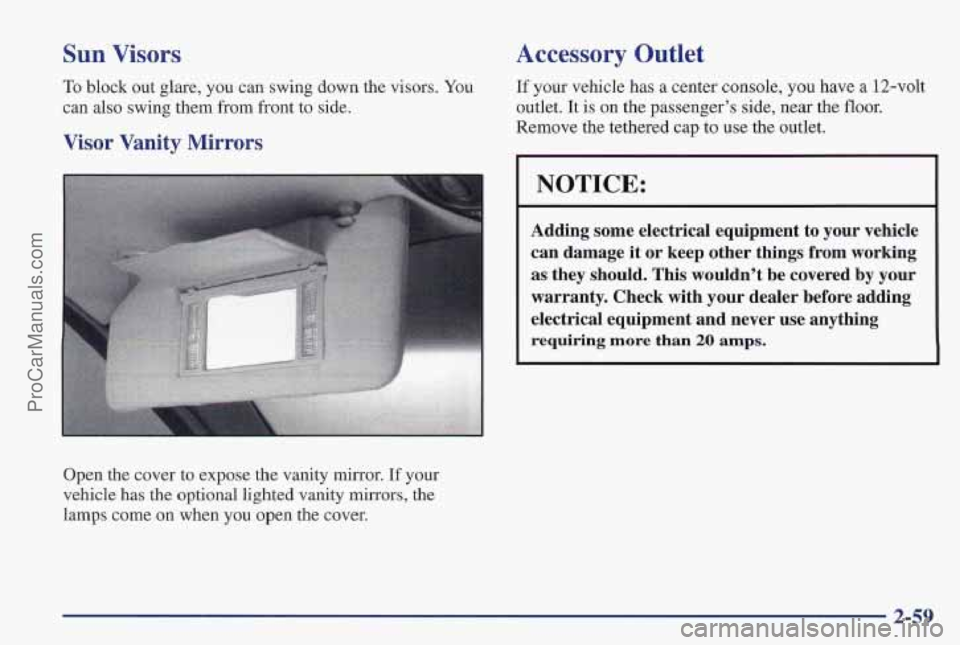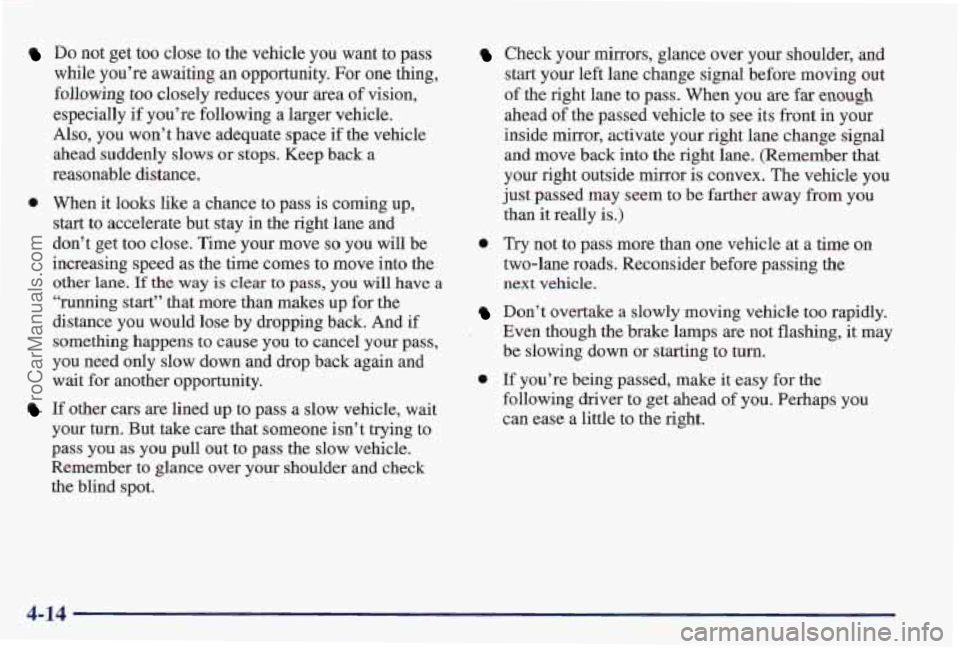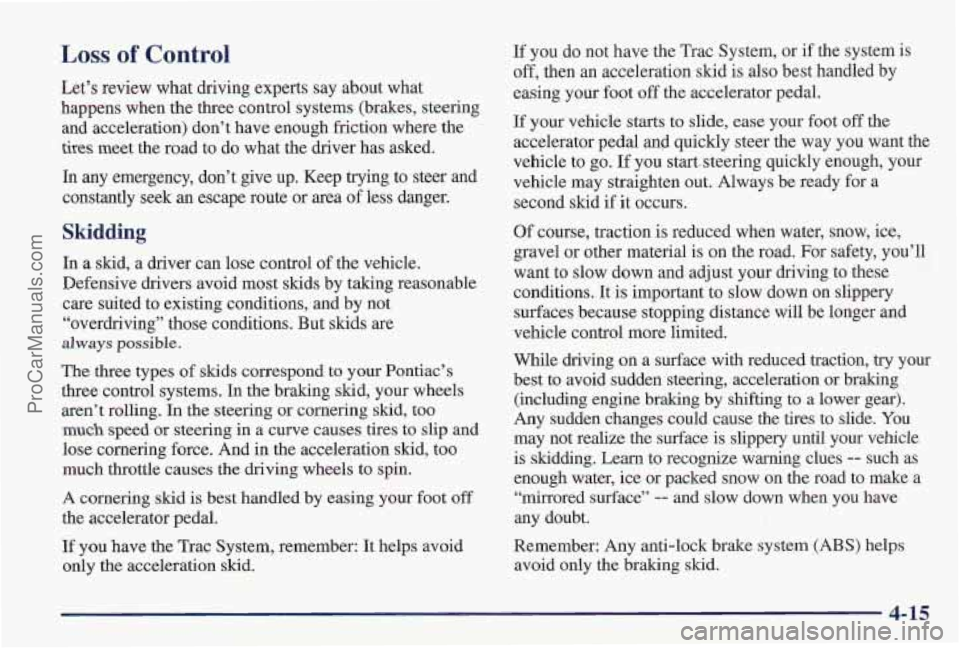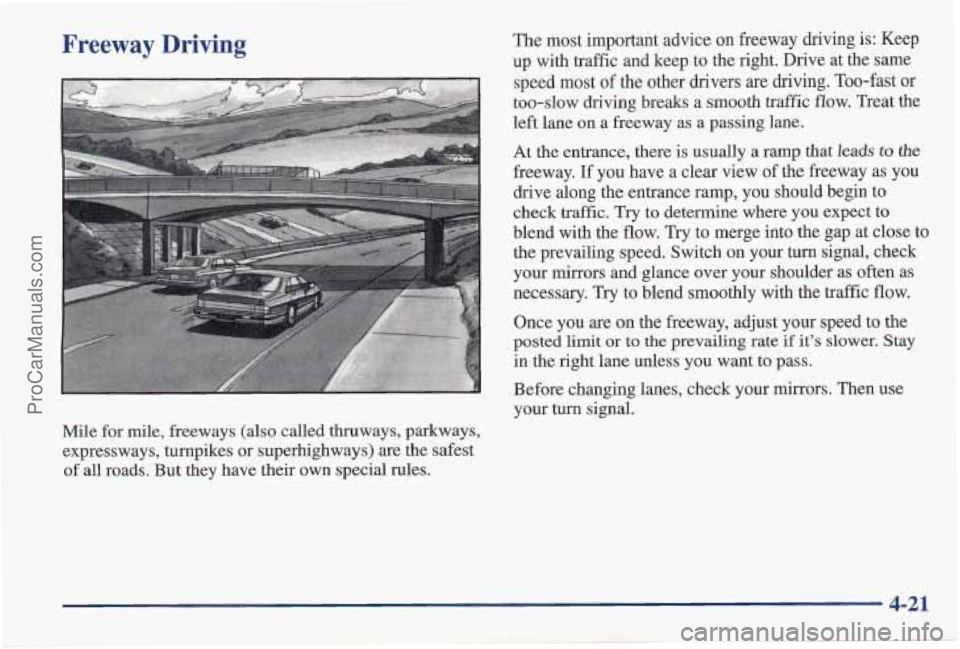1997 PONTIAC PONTIAC mirror
[x] Cancel search: mirrorPage 75 of 419

v Section 2 Features and Controls
Here you can learn about the many standard and optional features on your Pontiac, and information on starting,
shifting and braking. Also explained are the instrument panel and the warning systems that tell you if everything is
working properly
-- and what to do if you have a problem.
2-2
2-4
2-8
2- 10
2-12
2-15
2-15
2- 16
2-18
2-19
2-24
2-29
2-30
2-3 1
Important Information About Keys
Door Locks
Remote Keyless Entry Battery Replacement for RKE
Preventing Theft
of Your Vehicle
New Vehicle “Break-In”
Ignition Positions
Tips on Starting Your Engine
Using the Engine Coolant Heater
Automatic Transaxle Operation
Parking Brake Guidelines
Important Information on Engine Exhaust
Operation of Your Windows
Adjusting the Tilt Steering Wheel 2-32
2-33
2-33
2-35
2-3 8
2-39
2-40
2-5 3
2-54
2-62
2-64
2-78
2-83
Functions of the Multifunction Lever
How to Use the HighLow Beam
Headlamp Changer
Windshield Wipers and Fluid
Using Cruise Control
Exterior Lamps
Daytime Running Lamps
(DRL)
Interior Lamps
Rearview Mirrors
Storage Compartments
Instrument Panel Overview
All About Your Warning Lights and Gages
Driver Information Center
Head-Up Display
2-1
ProCarManuals.com
Page 127 of 419

Mirrors
Adjust all the mirrors so you can see clearly when you
are sitting in a comfortable driving position.
Inside Daymight Rearview Mirror Electrochromic
Daymight Rearview Mirror
(If Equipped)
To reduce glare from lamps behind you, push the lever
away from you (to the night position). To return the mirror
back to the day position, pull the lever toward you. Your
Pontiac may have an electrochromic dayhight
rearview mirror. Push the button on the bottom of the
mirror to turn this feature on. The mirror will darken
gradually to reduce glare from headlamps behind you.
This may take
a few moments.
2-53
ProCarManuals.com
Page 128 of 419

One photocell on the front of the mirror senses when it
is becoming dark outside. Another photocell, facing
rearward, senses headlamps behind
you. To turn the
electrochromic feature off, press the button on the
bottom of the mirror again.
To keep the photocells operating well, occasionally
clean
them with a cotton swab and glass cleaner.
Power Outside Mirrors
Convex Outside Mirror
Your passenger’s side mirror is convex. A convex
mirror’s surface
is curved so you can see more from the
driver’s seat.
The electric mirror control
is near the driver’s window,
on the armrest. Turn the
control to the left to adjust
the left mirror or
to the right
to adjust the right mirror.
Then
move the control in
the direction you want to
move the mirror.
A convex mirror can make things (like other
vehicles)
Book farther away than they really are.
If you cut to’o sharply into the right lane, you
could hit
a vehicle on your right. Check your
insilde mirror or glance over your shoulder before
changing lanes.
Storage Compartments
Glove Box
Use the master key to lock and unlock the glove box. To
open, lift the right side
of the latch.
29.54
ProCarManuals.com
Page 133 of 419

Sun Visors
To block out glare, you can swing down the visors. You
can also swing them from front to side.
Visor Vanity Mirrors
Open the cover to expose the vanity mirror. If your
vehicle has the optional lighted vanity mirrors, the
lamps come on when you open the cover.
Accessory Outlet
If your vehicle has a center console, you have a 12-volt
outlet. It
is on the passenger’s side, near the floor.
Remove the tethered cap to use the outlet.
I NOTICE:
Adding some electrical equipment to your vehicle
can damage it or keep other things from working
as they should. This wouldn’t be covered by your
warranty. Check with your dealer before adding
electrical equipment and never use anything
requiring more than 20 amps.
2-59
ProCarManuals.com
Page 208 of 419

Do not get too close to the vehicle you want to pass
while you’re awaiting
an opportunity. For one thing,
following too closely reduces your area of vision,
especially if you’re following a larger vehicle.
Also, you won’t have adequate space if the vehicle
ahead suddenly slows or stops. Keep back a
reasonable distance.
0 When it looks like a chance to pass is coming up,
start to accelerate but stay in the right l’ane and
don’t get too close. Time your move
so you will be
increasing speed as the time comes to move into the
other lane. If the way is clear to pass, you will have a
“running start’’ that more than makes up for
the
distance you would lose by dropping back. And if
something happens to cause
you to cancel your pass,
you need only slow down and
drop back again and
wait for another opportunity.
If other cars are lined up to pass a slow vehicle, wait
your turn. But take care that someone isn’t trying to
pass you as you pull out to pass
the slow vehicle.
Remember to glance over your shoulder and check
the blind spot.
Check your mirrors, glance over your shoulder, and
start your left lane change signal before moving out
of the right lane to pass. When you are far enough
ahead of the passed vehicle to see its front in your
inside mirror, activate your right lane change signal
and move back into the right lane. (Remember that
your right outside mirror is convex. The vehicle you
just passed may seem to
be farther away from you
than it really is.)
0 Try not to pass more than one vehicle at a time on
two-lane roads, Reconsider before passing the
next vehicle.
Don’t overtake a 8slowly moving vehicle too rapidly.
, Even though the brake lamps are not flashing, it may
be slowing down or starting to turn.
0 If you’re being passed, make it easy for the
following driver to get ahead of you, Perhaps you
can ease
a little to the right.
4-14
ProCarManuals.com
Page 209 of 419

Loss of Control
Let’s review what driving experts say about what
happens when the three control systems (brakes, steering
and acceleration) don’t have enough friction where the
tires meet the road to do what the driver has asked.
In any emergency, don’t give up. Keep trying to steer and
constantly seek an escape route or area of less danger.
Skidding
In a skid, a driver can lose control of the vehicle.
Defensive drivers avoid most skids by taking reasonable
care suited to existing conditions, and by not
“overdriving” those conditions. But skids are
always possible.
The three types of skids correspond to your Pontiac’s
three control systems. In the braking skid, your wheels
aren’t rolling. In the steering or cornering
skid, too
much speed or steering in a curve causes tires to slip and
lose cornering force. And in the acceleration skid, too
much throttle causes the driving wheels to spin.
A cornering
skid is best handled by easing your foot off
the accelerator pedal.
If you have the Trac System, remember: It helps avoid
only the acceleration skid. If
you do not have the Trac System, or if the system is
off, then an acceleration skid is also best handled by
easing your foot off
the accelerator pedal.
If your vehicle starts to slide, ease your foot off the
accelerator pedal and quickly steer the way you want the
vehicle to go.
If you start..steering quickly enough, your
vehicle may straighten out. Always be ready for a
second slud
if it occurs.
Of course, traction is reduced when water, snow, ice,
gravel or other material
is on the road. For safety, you’ll
want to slow down and adjust your driving to these
conditions. It
is important to slow down on slippery
surfaces because stopping distance will be longer and
vehicle control more limited.
While driving on a surface with reduced traction,
try your
best to avoid sudden steering, acceleration or braking
(including engine braking by shifting
to a lower gear).
Any sudden changes could cause the tires to slide. You
may not realize the surface is slippery until your vehicle
is skidding. Learn to recognize warning clues -- such as
enough water, ice or packed snow on
the road to make a
“mirrored surface”
-- and slow down when you have
any doubt.
Remember: Any anti-lock brake system (ABS) helps
avoid only the braking skid.
4-15
ProCarManuals.com
Page 210 of 419

Driving at Night
Night driving is more dangerous than day driving.
One reason is that some drivers
are likely to be
impaired
-- by alcohol or drugs, with night vision
problems,
or by fatigue.
Here are some tips on night driving.
0 Drive defensively.
e
0
e
Don’t drink and drive.
Adjust your inside rearview mirror to reduce the
glare from headlamps behind
you.
Since you can’t see as well, you may need to
slow down and keep more space between
you and
other vehicles.
Slow down, especially on higher speed roads. Your
headlamps can light up only
so much road ahead.
In remote areas, watch for animals.
If you’re tired, pull off the road in a safe place
and rest.
Night Vision
No one can see as well at night as in the daytime. But as
we get older these differences increase. A 50-year-old
driver may require
at least twice as much light to see the
same thing at night
as a 20-year-old.
What you
do in the daytime can also affect your night
vision.
For example, if you spend the day in bright
sunshine you
are wise to wear sunglasses. Your eyes
will have less trouble adjusting to night. But if you’re
driving, don’t wear sunglasses at night. They may cut
down on glare
from headlamps, but they also make a lot
of things invisible.
4- 16
ProCarManuals.com
Page 215 of 419

Freeway Driving The most important advice on freeway driving is: Keep
up with traffic and keep to the right. Drive at the same
Mile for mile, freeways
(also called thruways, parkways,
expressways, turnpikes or superhighways)
are the safest
of all roads. But they have their own special rules. drive
along-the entrance ramp, you should begin to
-
check traffic. Try to determine where you expect to
blend with the flow. Try to merge into the gap at close to
the prevailing speed. Switch on your turn signal, check
your mirrors and glance over your shoulder as often as
necessary. Try to blend smoothly with the traffic flow.
Once you
are on the freeway, adjust your speed to the
posted
limit or to the prevailing rate if it's slower. Stay
in the right lane unless you want to pass.
Before changing lanes, check your mirrors. Then use
your turn signal.
ProCarManuals.com